
A firefighter is a first responder trained in firefighting, primarily to control and extinguish fires that threaten life and property, as well as to rescue persons from confinement or dangerous situations. Male firefighters are sometimes referred to as firemen.

The New York City Fire Department, officially the Fire Department of the City of New York (FDNY) is the full-service fire department of New York City, serving all five boroughs. The FDNY is responsible for fire suppression and fire prevention, and is a major provider of EMS services in New York City. Beyond fire suppression and EMS, the FDNY is responsible for a broad range of services, including technical rescue, CBRN defense, and structural collapse response and analysis. The FDNY is equipped with a wide variety of general-purpose and specialized fire apparatus to serve its varied missions.
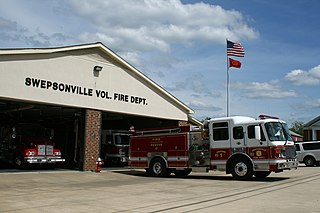
A volunteer fire department (VFD) is a fire department of volunteers who perform fire suppression and other related emergency services for a local jurisdiction. Volunteer and retained (on-call) firefighters are expected to be on call to respond to emergency calls for long periods of time, and are summoned to the fire station when their services are needed. They are also expected to attend other non-emergency duties as well.
Firefighting jargon includes a diverse lexicon of both common and idiosyncratic terms. One problem that exists in trying to create a list such as this is that much of the terminology used by a particular department is specifically defined in their particular standing operating procedures, such that two departments may have completely different terms for the same thing. For example, depending on whom one asks, a safety team may be referred to as a standby, a RIT or RIG or RIC, or a FAST. Furthermore, a department may change a definition within its SOP, such that one year it may be RIT, and the next RIG or RIC.
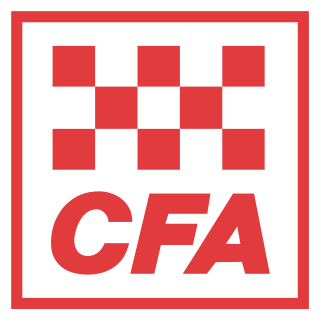
The Country Fire Authority (CFA) is a volunteer fire service responsible for fire suppression, rescues, and response to other accidents and hazards across most of the state Victoria, Australia. CFA comprises over 1,200 brigades organised in 21 districts, and shares responsibility for fire services with Fire Rescue Victoria (FRV), which employs full-time paid firefighters in major urban areas; and Forest Fire Management Victoria (FFMV), which manages fire prevention and suppression on Victoria's public lands. CFA operations and equipment are partly funded by the Victorian Government through its Fire Services Levy, and supplemented by individual brigades' fundraising for vehicles and equipment.

The South Australian Country Fire Service is a volunteer based fire service in the Australian state of South Australia. The CFS has responsibility as the Control Agency for firefighting, rescues and hazardous materials and inland waterways in the country regions of South Australia. Its official mission is "To protect life, property and the environment from fire and other emergencies whilst protecting and supporting our personnel and continuously improving."
The Arlington County Fire Department (ACFD) provides fire, emergency medical, and allied public safety services for Arlington County and the City of Falls Church in Virginia, USA. It is highly regarded within the profession as an innovator and leader in enhancing the industry. Among its many firsts are the hiring of the first female career firefighter in the world in 1974 and partnering with the United States Public Health Service to develop America's first Metropolitan Medical Strike Team to respond to the consequences of a chemical, biological or radiological terrorist attack.

The Department of Fire and Emergency Services (DFES) is a government department that is responsible for fire and emergency services in Western Australia. The department came into being in 2012 as a result of the Perth Hills Bush Fire review.DFES is responsible for the management, training and funding of career and volunteer Services including:
The New Zealand Fire Service was New Zealand's main firefighting body from 1 April 1976 until 1 July 2017 – at which point it was dissolved and incorporated into the new Fire and Emergency New Zealand.
As firefighting has a rich history throughout the world, traditions in this profession vary widely from country to country.
In the United Kingdom and Ireland, a retained firefighter, also known as an RDS firefighter or on-call firefighter, is a firefighter who does not work on a fire station full-time but is paid to spend long periods of time on call to respond to emergencies through the Retained Duty System. Many have full-time jobs outside of the fire service. Retained firefighters are employed and trained by the local fire and rescue service.
Emergency medical services in Australia are provided by state ambulance services, which are a division of each state or territorial government, and by St John Ambulance in both Western Australia and the Northern Territory.

The Prince George's County Fire/EMS Department (PGFD) is a combination career/volunteer county-level agency that provides "..fire prevention, fire protection, emergency medical services, rescue services and community outreach programs" for residents of Prince George's County, Maryland. The department is composed of volunteers from 33 fire companies throughout the county, that are represented by the Prince George's County Volunteer Fire & Rescue Association, as well as career firefighters affiliated with the Prince George's County Professional Firefighters and Paramedics Association, IAFF Local 1619. According to the Firehouse Magazine 2010 Combination Fire Department Run Survey, the Prince George's County Fire/EMS Department covers a response area of approximately 580 miles, protects approximately 900,000 people, and has an annual operating budget of $132 million. Prince George's County Fire/EMS Department responded to 148,506 calls in 2016 according to the 2016 National Run Survey. 29,702 of those calls were fire related and 118,804 that were EMS calls, making Prince George's County Fire/EMS Department the busiest combination fire department in the United States to submit statistics.
The Dutchess County Department Of Emergency Response has the responsibility of governing Emergency operations in Dutchess County, New York. This encompasses Police, Fire and EMS.

Firefighting in the United States dates back to the earliest European colonies in the Americas. Early firefighters were simply community members who would respond to neighborhood fires with buckets. The first dedicated volunteer fire brigade was established in 1736 in Philadelphia. These volunteer companies were often paid by insurance companies in return for protecting their clients.

The Baltimore City Fire Department (BCFD) provides fire protection and emergency medical services to the city of Baltimore, Maryland, United States. Founded in 1797 and established in 1859, the Baltimore City Fire Department covers an area of 81 square miles (210 km2) of land and 11 square miles (28 km2) of water, with a resident population of over 640,000 and a daytime population of over 1,000,000. The BCFD responds to approximately 235,000 emergency calls annually. There are two International Association of Fire Fighters (IAFF) locals; IAFF 734 for firefighters and IAFF 964 for officers.

The Vancouver Fire Department (VFD) provides fire protection and emergency medical services to the city of Vancouver and, by contract, Clark County Fire District 5, in Washington, United States. The VFD's response area is 91 square miles (240 km2) with a population of over 288,000 (2021). The VFD has the highest call volume per firefighter in the state. ALS transport is provided by AMR, making the VFD's service area population by far the largest in Western Washington without public ALS ambulance service.
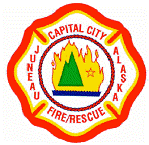
Capital City Fire/Rescue (CCFR) provides fire suppression and emergency medical services to the city of Juneau, Alaska, United States.
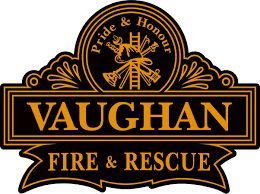
Vaughan Fire and Rescue Services (VFRS) provides fire protection, technical rescue services, hazardous materials response, and first responder emergency medical assistance to the city of Vaughan, Ontario. It operates 10 fire stations and coordinates with other fire departments in York Region and the Greater Toronto Area. VFRS received a 100 per cent satisfaction rating in the City of Vaughan’s 2018 Citizen Survey.
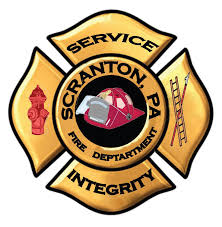
The Scranton Fire Department provides fire protection, rescue services, hazardous materials mitigation, to the City of Scranton, Pennsylvania. The department used volunteer fire companies throughout its history and was established as a career fire department on May 4, 1901. The city maintained a combination of paid and volunteer firefighters from 1901 to 1907 when a full time department was established. The Scranton Fire Department remains a full-time all career department today, with a total of about 142 professional firefighters and fire officers protecting the City of Scranton.












